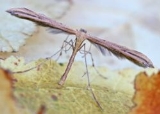
Emmelina monodactyla
Encyclopedia
The T-Moth or Morning-glory Plume Moth (Emmelina monodactyla) is a moth
of the family Pterophoroidea. It is found in Europe
, Japan
, central Asia
, North Africa
and North America
.
The wingspan
is 18-27 mm. The moths fly nearly year-round.
The larvae mainly feed on Convolvulaceae
species, including Atriplex
(including Atriplex patula
), Chenopodium
(including Chenopodium album
), Calystegia sepium
, Calystegia spithamaea, Calystegia sodanella, Cynara cardunculus, Convolvulus arvensis
, Convolvulus cantabrica
, Convolvulus floridus, Convolvulus prostrates, Convolvulus tricolor
, Ipomoea batatas, Ipomoea eriocarpa and Ipomoea purpurea
, but also Datura stramonium
and Hyoscyamus niger from the Solanaceae
family.
Moth
A moth is an insect closely related to the butterfly, both being of the order Lepidoptera. Moths form the majority of this order; there are thought to be 150,000 to 250,000 different species of moth , with thousands of species yet to be described...
of the family Pterophoroidea. It is found in Europe
Europe
Europe is, by convention, one of the world's seven continents. Comprising the westernmost peninsula of Eurasia, Europe is generally 'divided' from Asia to its east by the watershed divides of the Ural and Caucasus Mountains, the Ural River, the Caspian and Black Seas, and the waterways connecting...
, Japan
Japan
Japan is an island nation in East Asia. Located in the Pacific Ocean, it lies to the east of the Sea of Japan, China, North Korea, South Korea and Russia, stretching from the Sea of Okhotsk in the north to the East China Sea and Taiwan in the south...
, central Asia
Asia
Asia is the world's largest and most populous continent, located primarily in the eastern and northern hemispheres. It covers 8.7% of the Earth's total surface area and with approximately 3.879 billion people, it hosts 60% of the world's current human population...
, North Africa
North Africa
North Africa or Northern Africa is the northernmost region of the African continent, linked by the Sahara to Sub-Saharan Africa. Geopolitically, the United Nations definition of Northern Africa includes eight countries or territories; Algeria, Egypt, Libya, Morocco, South Sudan, Sudan, Tunisia, and...
and North America
North America
North America is a continent wholly within the Northern Hemisphere and almost wholly within the Western Hemisphere. It is also considered a northern subcontinent of the Americas...
.
The wingspan
Wingspan
The wingspan of an airplane or a bird, is the distance from one wingtip to the other wingtip. For example, the Boeing 777 has a wingspan of about ; and a Wandering Albatross caught in 1965 had a wingspan of , the official record for a living bird.The term wingspan, more technically extent, is...
is 18-27 mm. The moths fly nearly year-round.
The larvae mainly feed on Convolvulaceae
Convolvulaceae
Convolvulaceae, known commonly as the bindweed or morning glory family, are a group of about 60 genera and more than 1,650 species of mostly herbaceous vines, but also trees, shrubs and herbs.- Description :...
species, including Atriplex
Atriplex
Atriplex is a plant genus of 100-200 species, known by the common names of saltbush and orache . The genus is quite variable and widely distributed. It includes many desert and seashore plants and halophytes, as well as plants of moist environments...
(including Atriplex patula
Atriplex patula
Atriplex patula L. is a ruderal, circumboreal species of annual herbaceous plants in the genus Atriplex naturalized in many temperate regions....
), Chenopodium
Chenopodium
Chenopodium is a genus of about 150 species of perennial or annual herbaceous flowering plants known as the goosefoots, which occur almost anywhere in the world. It is placed in the family Amaranthaceae in the APG II system; older classifications separate it and its relatives as Chenopodiaceae, but...
(including Chenopodium album
Chenopodium album
Chenopodium album is a fast-growing weedy annual plant in the genus Chenopodium.Though cultivated in some regions, the plant is elsewhere considered a weed...
), Calystegia sepium
Calystegia sepium
Calystegia sepium is a species of bindweed, with a subcosmopolitan distribution throughout temperate Northern Hemisphere in Europe, Asia, northwestern Africa, and North America, and in the temperate Southern Hemisphere in Australia, and...
, Calystegia spithamaea, Calystegia sodanella, Cynara cardunculus, Convolvulus arvensis
Convolvulus arvensis
Convolvulus arvensis is a species of bindweed, native to Europe and Asia. It is a climbing or creeping herbaceous perennial plant growing to 0.5–2 m high. The leaves are spirally arranged, linear to arrowhead-shaped, 2–5 cm long and alternate, with a 1–3 cm petiole...
, Convolvulus cantabrica
Convolvulus cantabrica
Convolvulus cantabrica, common name Cantabrican Morning Glory or Dwarf morning glory, is a herbaceous perennial plant belonging to the genus Convolvulus of the Convolvulaceae family.-Description:...
, Convolvulus floridus, Convolvulus prostrates, Convolvulus tricolor
Convolvulus tricolor
Convolvulus tricolor , is a species of morning glory known by the common name Dwarf Morning Glory.- Description :It is a short to medium annual plant with solitary long-stalked flowers. The flower is a tri-coloured funnel-shaped bloom about three centimeters wide, blue with white and a yellow centre...
, Ipomoea batatas, Ipomoea eriocarpa and Ipomoea purpurea
Ipomoea purpurea
Ipomoea purpurea, the Purple, Tall, or Common Morning Glory, is a species in the genus Ipomoea, native to Mexico and Central America. Like all morning glories the plant entwines itself around structures, growing to a height of 2–3 m tall. The leaves are heart-shaped and the stems are covered with...
, but also Datura stramonium
Datura stramonium
Datura stramonium, known by the common names Jimson weed, devil's trumpet, devil's weed, thorn apple, tolguacha, Jamestown weed, stinkweed, locoweed, datura, pricklyburr, devil's cucumber, Hell's Bells, moonflower and, in South Africa, malpitte and mad seeds, is a common weed in the...
and Hyoscyamus niger from the Solanaceae
Solanaceae
Solanaceae are a family of flowering plants that include a number of important agricultural crops as well as many toxic plants. The name of the family comes from the Latin Solanum "the nightshade plant", but the further etymology of that word is unclear...
family.

